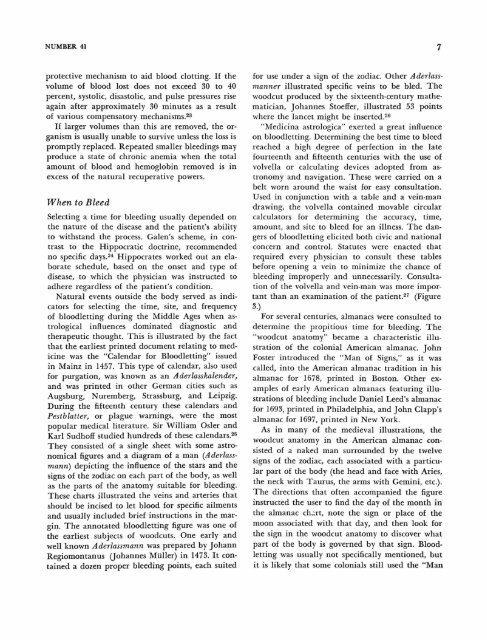BLOODLETTING INSTRUMENTS - Smithsonian Institution Libraries
BLOODLETTING INSTRUMENTS - Smithsonian Institution Libraries
BLOODLETTING INSTRUMENTS - Smithsonian Institution Libraries
Create successful ePaper yourself
Turn your PDF publications into a flip-book with our unique Google optimized e-Paper software.
NUMBER 41<br />
protective mechanism to aid blood clotting. If the<br />
volume of blood lost does not exceed 30 to 40<br />
percent, systolic, disastolic, and pulse pressures rise<br />
again after approximately 30 minutes as a result<br />
of various compensatory mechanisms.^^<br />
If larger volumes than this are removed, the organism<br />
is usually unable to survive unless the loss is<br />
promptly replaced. Repeated smaller bleedings may<br />
produce a state of chronic anemia when the total<br />
amount of blood and hemoglobin removed is in<br />
excess of the natural recuperative powers.<br />
When to Bleed<br />
Selecting a time for bleeding usually depended on<br />
the nature of the disease and the patient's ability<br />
to withstand the process. Galen's scheme, in contrast<br />
to the Hippocratic doctrine, recommended<br />
no specific days.^* Hippocrates worked out an elaborate<br />
schedule, based on the onset and type of<br />
disease, to which the physician was instructed to<br />
adhere regardless of the patient's condition.<br />
Natural events outside the body served as indicators<br />
for selecting the time, site, and frequency<br />
of bloodletting during the Middle Ages when astrological<br />
influences dominated diagnostic and<br />
therapeutic thought. This is illustrated by the fact<br />
that the earliest printed document relating to medicine<br />
was the "Calendar for Bloodletting" issued<br />
in Mainz in 1457. This type of calendar, also used<br />
for purgation, was known as an Aderlasskalender,<br />
and was printed in other German cities such as<br />
Augsburg, Nuremberg, Strassburg, and Leipzig.<br />
During the fifteenth century these calendars and<br />
Pestblatter, or plague warnings, were the most<br />
popular medical literature. Sir William Osier and<br />
Karl Sudhoff studied hundreds of these calendars.^s<br />
They consisted of a single sheet with some astronomical<br />
figures and a diagram of a man (Aderlassmann)<br />
depicting the influence of the stars and the<br />
signs of the zodiac on each part of the body, as well<br />
as the parts of the anatomy suitable for bleeding.<br />
These charts illustrated the veins and arteries that<br />
should be incised to let blood for specific ailments<br />
and usually included brief instructions in the margin.<br />
The annotated bloodletting figure was one of<br />
the earliest subjects of woodcuts. One early and<br />
well known Aderlassmann was prepared by Johann<br />
Regiomontanus (Johannes Miiller) in 1473. It contained<br />
a dozen proper bleeding points, each suited<br />
for use under a sign of the zodiac. Other Aderlassmanner<br />
illustrated specific veins to be bled. The<br />
woodcut produced by the sixteenth-century mathematician,<br />
Johannes Stoeffer, illustrated 53 points<br />
where the lancet might be inserted.^^<br />
"Medicina astrologica" exerted a great influence<br />
on bloodletting. Determining the best time to bleed<br />
reached a high degree of perfection in the late<br />
fourteenth and fifteenth centuries with the use of<br />
volvella or calculating devices adopted from astronomy<br />
and navigation. These were carried on a<br />
belt worn around the waist for easy consultation.<br />
Used in conjunction with a table and a vein-man<br />
drawing, the volvella contained movable circular<br />
calculators for determining the accuracy, time,<br />
amount, and site to bleed for an illness. The dangers<br />
of bloodletting elicited both civic and national<br />
concern and control. Statutes were enacted that<br />
required every physician to consult these tables<br />
before opening a vein to minimize the chance of<br />
bleeding improperly and unnecessarily. Consultation<br />
of the volvella and vein-man was more important<br />
than an examination of the patient.^^ (Figure<br />
3.)<br />
For several centuries, almanacs were consulted to<br />
determine the propitious time for bleeding. The<br />
"woodcut anatomy" became a characteristic illustration<br />
of the colonial American almanac. John<br />
Foster introduced the "Man of Signs," as it was<br />
called, into the American almanac tradition in his<br />
almanac for 1678, printed in Boston. Other examples<br />
of early American almanacs featuring illustrations<br />
of bleeding include Daniel Leed's almanac<br />
for 1693, printed in Philadelphia, and John Clapp's<br />
almanac for 1697, printed in New York.<br />
As in many of the medieval illustrations, the<br />
woodcut anatomy in the American almanac consisted<br />
of a naked man surrounded by the twelve<br />
signs of the zodiac, each associated with a particular<br />
part of the body (the head and face with Aries,<br />
the neck with Taurus, the arms with Gemini, etc.).<br />
The directions that often accompanied the figure<br />
instructed the user to find the day of the month in<br />
the almanac chart, note the sign or place of the<br />
moon associated with that day, and then look for<br />
the sign in the woodcut anatomy to discover what<br />
part of the body is governed by that sign. Bloodletting<br />
was usually not specifically mentioned, but<br />
it is likely that some colonials still used the "Man
















